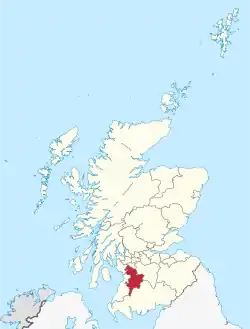Glencairn Aisle
The Glencairn Aisle or Glencairn Vault at Kilmaurs, East Ayrshire is a vaulted chamber containing a large memorial monument as well as the burial crypt of the Earls of Glencairn and their family members. It houses an exceptional ornately carved stone monument dated 1600 that commemorates James Cunningham, the 7th Earl of Glencairn, his countess, Margaret and eight of their children.[2] It is the oldest such monument in Ayrshire, the others being the Bargany Aisle at Ballantrae of 1601, the Skelmorlie Aisle at Largs of 1639 and the Hamilton Aisle at Dunlop of 1641.[3]
| Glencairn Aisle | |
|---|---|
| Riccarton, East Ayrshire, Scotland UK grid reference NS414407 | |
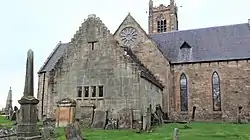 The Glencairn Aisle and St Maurs-Glencairn Church | |
 Glencairn Aisle | |
| Coordinates | 55.634464°N 4.5200130°W |
| Type | A Burial Aisle and crypt |
| Site information | |
| Owner | Clan Cunningham |
| Open to the public | By arrangement |
| Condition | Maintained |
| Site history | |
| Built | 16th century |
| Built by | James Cunningham, 7th Earl of Glencairn |
| In use | 16th to 20th centuries |
| Materials | Ashlar masonry[1] |
The aisle is associated with St Maurs-Glencairn parish church that is dedicated to St Mora or Maura[4] of Little Cumbrae and was gifted to Kelso Abbey in 1170 by Robertus filli Wernebaldi, an ancestor of the Cunninghams.[4] In 1413, it was endowed as a college of secular canons. In 1600, James, seventh Earl of Glencairn, added the Glencairn Aisle or Vault to the existing East-West orientated church building.[5] In the aisle there is the aforementioned early 17th century mural monument (1600) commissioned by James, Seventh Earl of Glencairn for himself, his countess, Margaret and his children.[6]
The Cunninghams, Earls of Glencairn

Kilmaurs has had strong links with the Cunningham family who were also associated with the lands of Lambroughton for a significant period during their rise to power. The Cunningham chiefs had a weaker connection with the barony of Kilmaurs after 1484 when Finlaystone became the family seat; Sir William Cunningham of Kilmaurs had married Margaret Denniston, sole heir to Sir Robert Denniston in 1405, and the dowry included the baronies of Denniston and Finlaystone in Renfrewshire, the lands of Kilmaronock in Dunbartonshire , and the barony of Glencairn in Dumfriesshire.[7]
In 1786 James, the fourteenth Earl of Glencairn, broke the centuries-old connection of the Cunningham family with the area by selling the Barony and estate of Kilmaurs, including Kilmaurs place, in 1786 to the Marchioness of Titchfield.[8] A story is told of Lady Jean, eldest daughter of James, being contracted to marry the Earl of Csssillis, however he refused to honour the agreement and she died of grief the same day. She is interned within the aisle.[9]
The Glencairn Aisle

The aisle has seen a number of substantial changes since its construction. Originally it was joined to the church with only a hand rail or screen separating the two and at this time the aisle effectively formed the south transept of the church, the mural monument was once therefore considered to be within the church proper.[10] The Roberton Aisle was located in the area that is now the main north entrance and gave the church an irregular cruciform appearance.[1]
After the aisle ceased to be used regularly the church in 1838 was forced to demolish the aisle's northern gable end due to its dangerous condition and this resulted in the aisle being shortened north-south by around six feet or 1.8m with a new gable wall being built.[10] Some time later the church session decided to create an external door that would allow the minister to enter the church in the pulpit area and this was entered off from the space between the aisle and the church.
The mural monument had stood in the middle of the west facing wall of the aisle, however these changes meant that it no longer stands in a central position as is clearly apparent to visitors.[10] At this time the aisle had a single small barred window and a metal gate to bar access via the doorway that was less than 6 feet high.[2][1]
A few courses of the side walls had fallen or were robbed of stone after the roof collapsed,[1] the replacement stone at restoration being still discernable. The internal walls of the aisle were once covered in plaster.[1] A divided pediment is once said to have crowned the monument.[9]
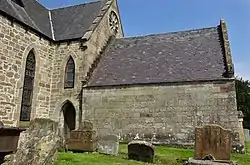
The gap between the buildings is mention by Adamson circa 1859 and is still shown on the OS map of 1895.[11][2] The church underwent extensive alterations in 1888, a spire being added, the old belfry on the west facing gable end was removed, the stone stairs on the east facing gable end likewise removed, etc. and at that time the aisle and church were once again joined together without however any internal access to the aisle, a doorway being placed on the west facing side.
A chamber once existed above the monument vault as indicated by the window in the south facing gable end,[1] however the roof collapsed and upon restoration a barrel vaulted roof was added below the slate roof, greatly reduced the height of the chamber above. The vaulted roof also reduced the height available for the mural monument.
Cavettos bearing the plain 'Y' 'Fork Over' heraldic symbol of the Cunningham's are located at both ends of the crow stepped south facing gable. A sun-dial on the east facing corner of the south gable of the Aisle is dated 1753, and was given to the church by William Coates, the minister from 1739 to 1778. A corbel on the previous northern gable has the inscription 'Rd 1846'[12] in reference to the date of the replacement of the roof. The building measures 7.5m or 25 feet by 7.0m or 23 feet and is built of grey ashlar masonry.[5]
The church once housed the parish school and the aisle and its monument suffered from the actions of the pupils, whilst in addition the local shoemakers removed good quality stone for use as whetstones.[13]
The Burial crypt
The crypt where the Cunningham family coffins were placed lies beneath the aisle and was accessed by a stone slab with two metal rings set into it. This access is no longer visible and may be covered by the stone flag floor that exists today. The crypt is approximately eight foot (2.4m) by eight foot(2.4m) and four feet (1.2m) deep and it is roughly hewn from the soft bedrock. A slope of unhewn rock was left to allow the coffins to be slid down into the cavity. The coffins were not covered or lined with lead[14] and therefore the wood has been exposed and rotted away almost entirely.

The last burial here, circa 1788, as reported by Johnnie Black the parish sexton,[14] was of a Mr. Hamilton of Bardowie who lived at Kilmaurs Place and claimed to be a relation of the Cunningham's of Glencairn.[15]
It is said that a polished red skull found in the crypt was the head of William, 9th Earl of Glencairn that was retained by his wife Lady Margaret out of love for her husband and this was eventually buried with her in the crypt.[16][14]
In 1842 a pair of Irish labourers, employed as navies on the construction of the new Kilmarnock railway, attended the burial of a colleague and afterwards, finding the aisle's door unlocked entered and using their tools broke into the crypt, leaving it exposed to the elements and to the ingress of rubbish, soil and masonry from the aisle and monument.[14] The wooden coffins had rotted and the bones of the individuals were randomly scattered throughout the crypt.
When in 1870 the parish schoolmaster Duncan McNaught and his assistants excavated the crypt as many as three cartloads of soil and rubbish were removed and the skulls of fifteen people were found.[17] All the bones were collected together and placed in a new chest and the details of the excavations and repairs were sealed in a container for later generations to find and read.[17] Dobie records that in circa 1806 twenty-one skulls or 'pows' in Scots were counted.[14]
The 7th Earl's Family Monument

James Cunningham married Margaret, daughter of Colin Campbell of Glenurchy and had at least two sons and six daughters. He married a second time after his wife's death, but had no issue.[18]
The children recorded in sculpture are Wiliam Coningham (Master of Glencairn)(VC); John (IC); Jean (JC); Katherine (KC); Margaret (MC); Susanna (SC); Ann (AC); Mary (MC). The term 'Master' was given to the eldest son. The two males are clearly identified as they are attired in male style clothing and have male hair styles. The six sister's gender is likewise shown by their clothing, etc. The age of the children appears to be registered through the height of their sculptures. The children appear to be in divided cubicles with the two males together in one. Only the two males have their initials in relief inside a short band as well as being indicated above with comparatively crude incised initials that are above the other children as well. These initials have the appearance of a much later addition by someone who was not an artisan.
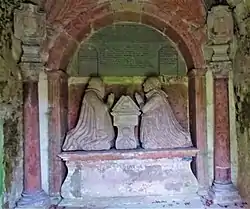
Beneath the male statues is a panel that reads "Wiliame Coninghame maister of Glencairn. Jhone Cunninghame". The reason for the spelling of their surname being different is not clear.[19]
The children's statues seem to retain signs of once being painted in bright colours such as exist at the 1641 Hamilton Mausoleum which was once so brightly coloured that it was locally known as the 'Picture House'. The Bargany or Kennedy Aisle monument at Ballantrae was also once brightly painted.[3]
Metal rosettes or initials may have been located in the six small empty squares that are located on the frieze and those on the base of the finials. The squares on the frieze show signs of them being forcibly prised off (See Wikimedia Commons link).[19] A monogram with "D.M.C" for the countess is clearly visible in a square on the right hand side above the columns.[20] A now mainly unreadable panel beneath the daughters recorded their names and some details of their marriages.[20]
Several panels once carried carved script however some are nearly or actually unreadable. The date "1600" is clear, as is the statement "Nothing surer than death, be therefore sober and watch in prayer."[21]
The monument has survived its various negative influences surprisingly well, partly due to its construction from locally sourced fine-grained freestone.[22]
The mason responsible for this monument left his mason's mark and his details on the right hand side of the monument on the central of the three receding pillars. The carving reads "Wroch Be David Scwgal masson bvrges in Carel." Carel stands for the town of Crail in Fife.[19] The mason used a mixture of Rennaisance motifs and medieval details, whilst the 1639 Skelmorie Aisle monument in Largs is entirely Rennaisance.[3] The same mason's mark appears on the Schaw Monument in Dunfermline Abbey.
Repair and restoration
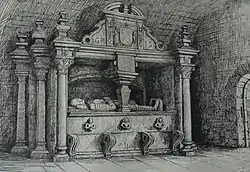
In 1793 the aisle was in a "shameful state of disrepair" but an appeal for funds for restoration was not successful.[13] Some minor alterations were carried out a few years later, such as the erection of a gate to restrict access, following the visit of Lady Don of Newton, sister of John, the last earl.[23] The aforementioned roof collapse knocked off finials and the sections above the cornice as well as breaking the book boards.[23]
In 1846 the roof was replaced[22] by Sir Alexander Montgomerie-Cunninghame of Corsehill, however no work was carried out on the monument.[23]
In 1870 Duncan McNaught, the local schoolmaster and local historian, was approached by Sir William Montgomerie-Cunninghame of Corsehill on behalf of his mother, with a request for assistance with the restoration of the 1600 AD monument to the 7th Earl of Glencairn, his countess and their children. The crypt beneath the aisle was first excavated with several cartloads of soil and rubbish removed and portions of the monument were recovered from this, reassembled and used as models for the restorations.[23] The monument was extensively restored by Robert Boyd, an employee of Messrs. Boyd and Forrest of Stewarton,[24] the work being carried out for Dame Charlotte Montgomery-Cunninghame to celebrate the memory of her husband Sir Thomas, who died in 1870, 8th Baronet of Corsehill and a descendant of the Earls of Glencairn through Andrew, second son of the 4th Earl.[2] A brass memorial plaque gives these details and has been moved to the west wall of the aisle from its previous location beneath the window on the south facing gable end.[2]
The Glencairn Aisle Trust in 1989 raised £3000 that was used to carry out external stone cleaning and the vault was re-roofed. Historic Scotland (sic) were contacted regarding restoration work on the monument but no record of works has been found.[22]
The Bargany or Kennedy Aisle at Ballantrae in South Ayrshire of 1601 appears to have used the Glencairn Aisle monument as a model and may therefore provide some clues as to the original appearance of the Glencairn Aisle monument and vice versa. It commemorates Gilbert Kennedy who was killed in 1601 in a feudal conflict by the Earl of Cassillis, aged only 25.[13]
References
- Dobie, John (1876). Cunninghame Topographised by Timothy Pont. John Tweed. p. 285.
- Adamson, Archibald (1879). Rambles Round Kilmarnock. Dunlop and Drennan. p. 147.
- Clow, Rob (2012). The Buildings of Scotland. Ayrshire and Arran. Yale University Press. p. 20. ISBN 9780300141702.
- Adamson, Archibald (1879). Rambles Round Kilmarnock. Dunlop and Drennan. p. 146.
- Canmore - The Glencairn Aisle
- Beattie, Robert (1993). Kilmaurs Past and Present. Kilmaurs Historical society. p. 14.
- Metcalfe, William M. (1905). A History of the County of Renfrew from the Earliest Times. Alexander Gardner. p. 121.
- Robertson (1823), Page 326.
- Bryden, Robert (1915). Ayrshire Monuments Etched by Robert Bryden. Stephen and Pollock. p. 13.
- McNaught, Duncan (1912). Kilmaurs Parish and Burgh. Alexander Gardner. p. 114.
- Ayrshire XVIII.5 (Kilmarnock; Kilmaurs) Publication date;1896 Revised:1895
- McNaught, Duncan (1912). Kilmaurs Parish and Burgh. Alexander Gardner. p. 132.
- Dobie, John (1876). Cunninghame Topographised by Timothy Pont. John Tweed. p. 286.
- Dobie, John (1876). Cunninghame Topographised by Timothy Pont. John Tweed. p. 288.
- McNaught, Duncan (1912). Kilmaurs Parish and Burgh. Alexander Gardner. p. 129.
- McNaught, Duncan (1912). Kilmaurs Parish and Burgh. Alexander Gardner. p. 130.
- McNaught, Duncan (1912). Kilmaurs Parish and Burgh. Alexander Gardner. p. 131.
- Robertson, George (1823). A Genealogical Account of the Principal Families in Ayrshire. Vol.1. p. 254.
- McNaught, Duncan (1912). Kilmaurs Parish and Burgh. Alexander Gardner. p. 128.
- McNaught, Duncan (1912). Kilmaurs Parish and Burgh. Alexander Gardner. p. 127.
- McNaught, Duncan (1912). Kilmaurs Parish and Burgh. Alexander Gardner. p. 126.
- Beattie, Robert (1993). Kilmaurs Past and Present. Kilmaurs Historical society. p. 17.
- McNaught, Duncan (1912). Kilmaurs Parish and Burgh. Alexander Gardner. p. 125.
- McNaught, Duncan (1912). Kilmaurs Parish and Burgh. Alexander Gardner. p. 124.
- Sources
- Adamson, Archibald R. (1879). Rambles Round Kilmarnock. Kilmarnock : Dunlop and Drennan. 'Standard Office'.
- Beattie, Robert (1993). Kilmaurs Past and Present. Kilmaurs Historical Society.
- Bryden, Robert (1915). Ayrshire Monuments Etched by Robert Bryden. Ayr : Steven and Pollock.
- Clow, Rob (2012). The Buildings of Scotland. Ayrshire and Arran. Yale University Press.ISBN 9780300141702.
- McNaught, Duncan (1912). Kilmaurs Parish and Burgh. Paisley : Alexander Gardner.
- Metcalfe, William M. (1905). A History of the County of Renfrew from the Earliest Times. Paisley : Alexander Gardner.
- Robertson, William (1908). Ayrshire. Its History and Historic Families. Vol. 2. Grimsay Press (2005). ISBN 1-84530-026-2.
- Robertson, George (1823). A Genealogical Account of the Principal Families in Ayrshire. Vol.1. Irvine.
External links
| Wikimedia Commons has media related to Glencairn Aisle. |
